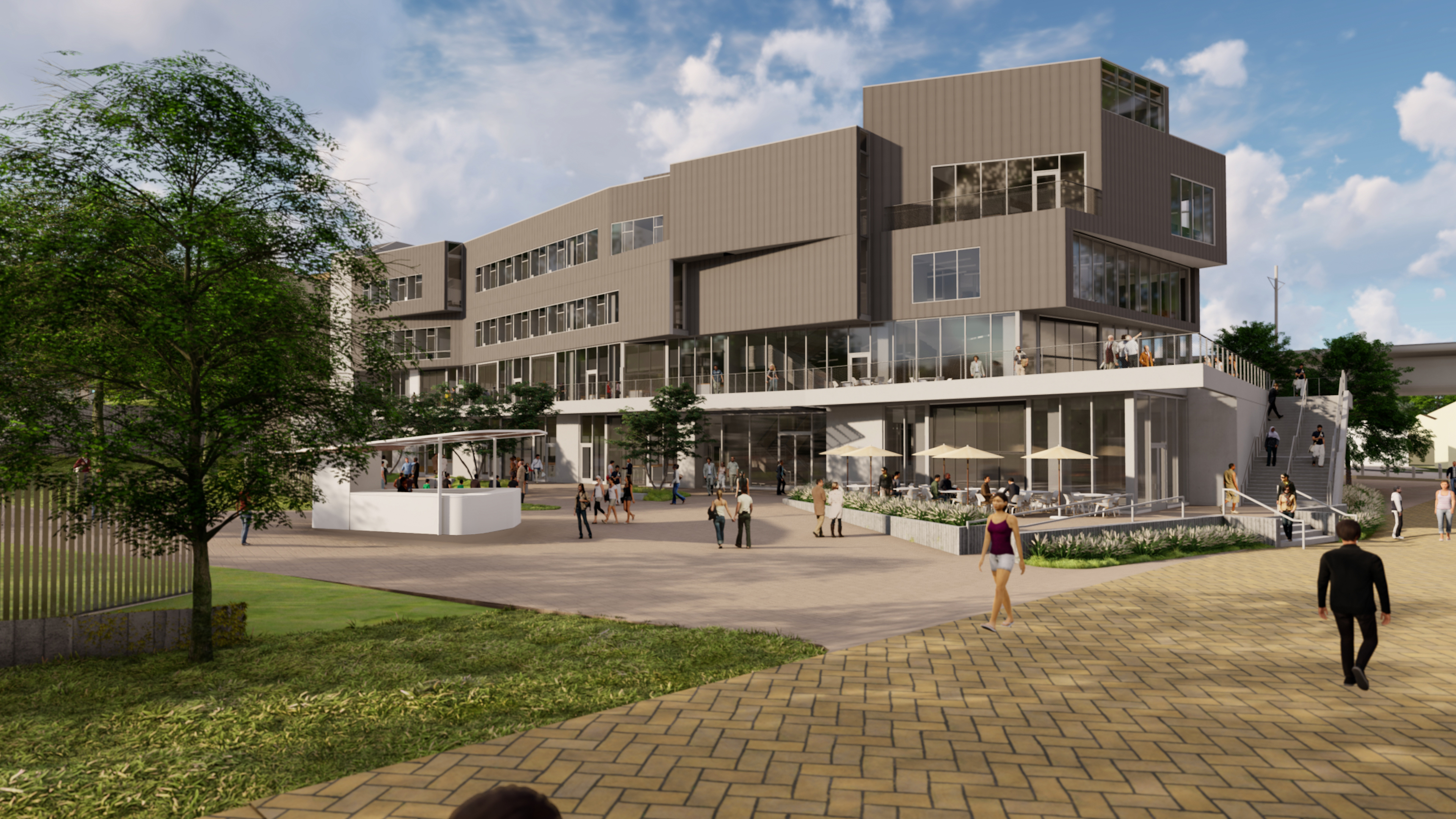Eatery Sought for Rental Car Center
Rendering of restaurant that would be placed at the new Rental Car Center at Lindberth Field.
Airport Authority Seeks
Restaurant Operator
Restaurateurs searching for a great new venue may soon be beating down the doors of the San Diego County Regional Airport Authority. That’s because the operator of Lindbergh Field is looking for a restaurant to fill a space atop the four-story, $316 million Rental Car Center that is being built at the airport.
Whoever gets the lease for that prime 7,900-square-foot space will be able to entice airline passengers and a lot more people with intimate views of the airport runway and panoramic view of the city’s skyline, bay and marinas.
“We are looking for this to become ‘San Diego’s restaurant,’” says Michael Spilky, president of Location Matters Brokerage Services, the company that was hired by the Airport Authority to find a suitable restaurant for the Rental Car Center, which is scheduled to open in 2016.
“We’re seeking to establish a unique brand that will resonate with the entire San Diego community and what we are all about: casual, yet refined, craft beer and cocktail-centric, and an approachable and local artisanal food experience,” said Spilky.
The space itself will contain 180 feet of floor-to-ceiling frontage and have a flexible layout with an outdoor patio seating opportunity. According to Location Matters, branding and signage opportunities exist on both sides of the building structure visible from Interstate 5. An exclusive elevator entry will take patrons swiftly to the restaurant entry.
Laying it on a little thickly, Spilky says: “This is a generational opportunity to be the restaurant we all talk about for the next 30 years; a sustainable place to woo your out-of-town guests, have a date night, or even a power lunch.”
Location Matters is marketing the lease for the restaurant space on an exclusive basis. Leasing inquiries can be made to Spilky at (858) 764-4223.
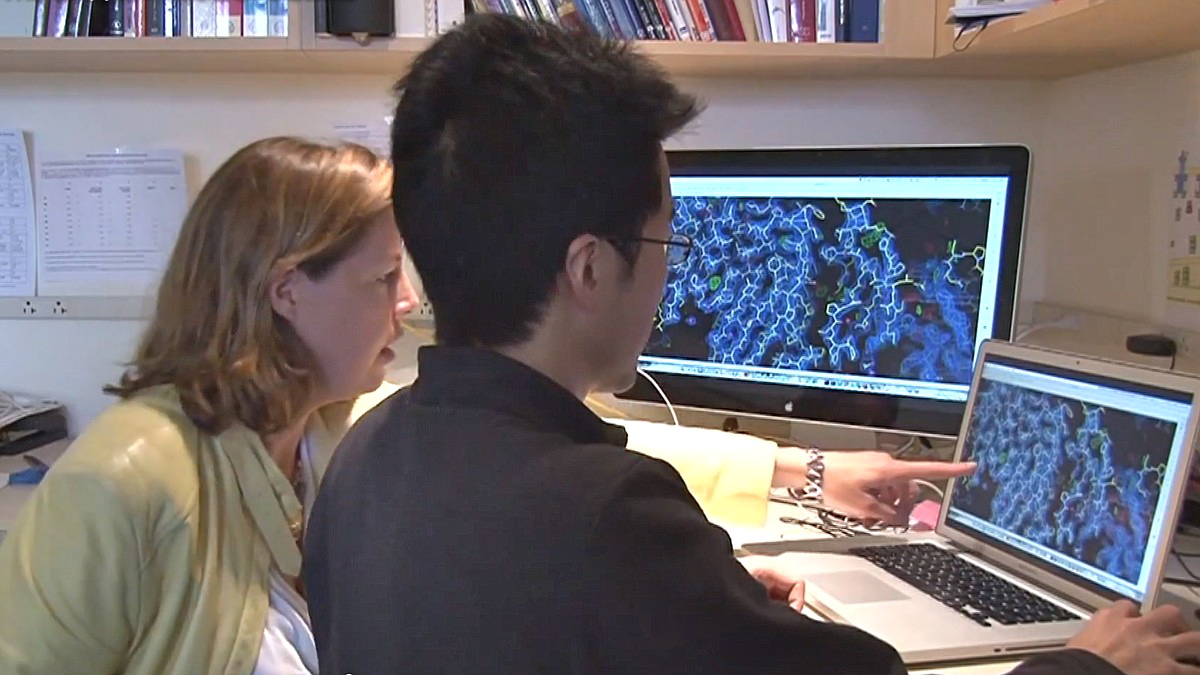
How Your Computer Can Help
Scientists Outsmart Ebola Virus
The Scripps Research Institute Wednesday announced an initiative in which people can make their idle computers and mobile devices available to scientists looking for compounds to treat the deadly Ebola virus.
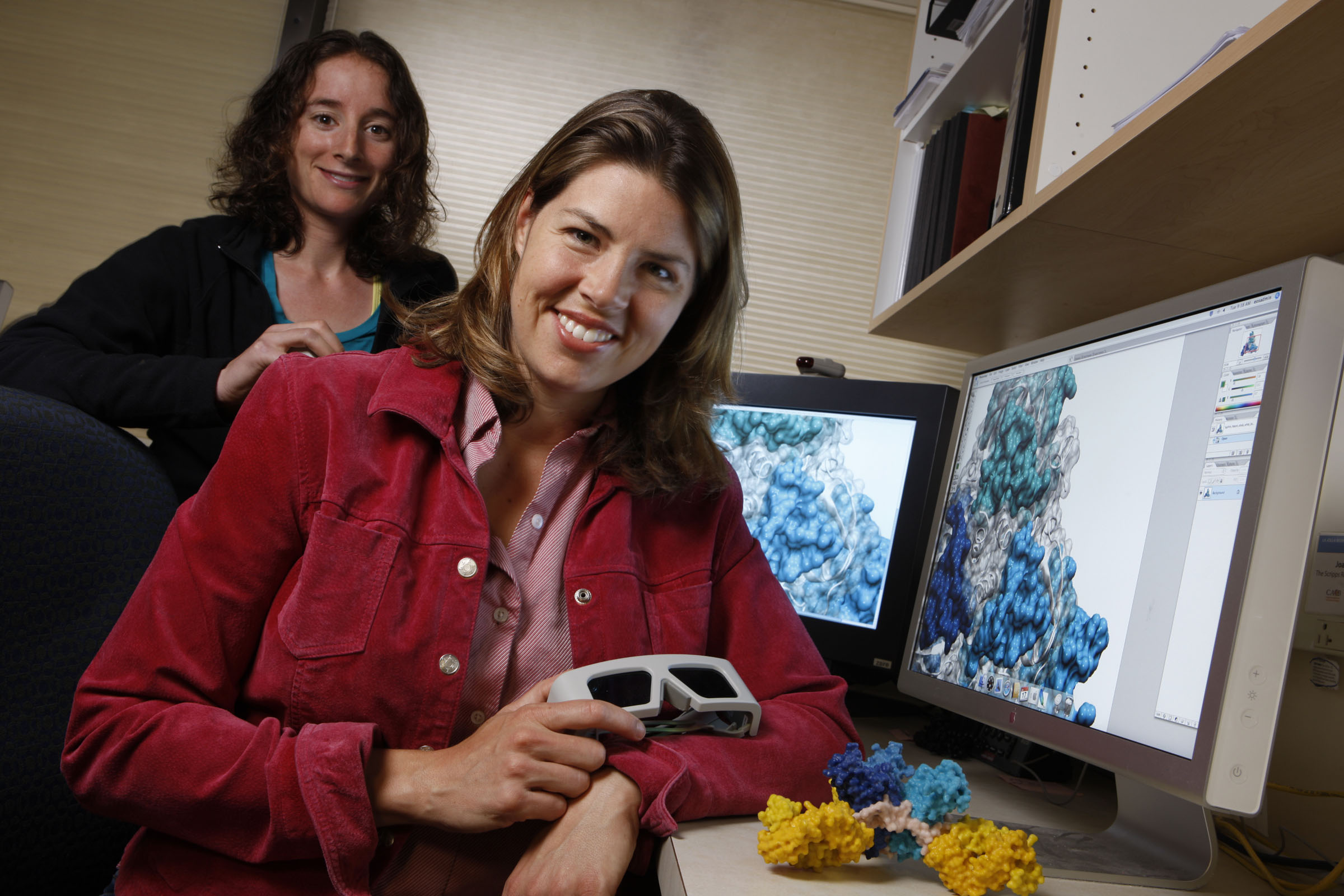
The “Outsmart Ebola Together” volunteer computing project is being run by the Ollmann Saphire laboratory at TSRI, which has mapped the structures and vulnerabilities of the proteins comprising the Ebola virus.
More attention is going into Ebola research following a deadly outbreak of the virus in West Africa. The flare-up resulted in the first cases ever in this country.
In the program, anyone with access to a computer or Android-based mobile device can download a safe and free application that will put their devices to work when the machines would otherwise be idle. With their collective processing power, the computers will form a virtual supercomputer to help TSRI screen millions of chemical compounds to identify new drug leads for treating Ebola.
The devices will remain fully available for normal use by their owners, according to TSRI.
The La Jolla-based research organization will run the program in partnership with the IBM World Community Grid, which has been making similar data-driven health and sustainability initiatives possible for 10 years as a free service to the science community.
According to TSRI, the best candidate compounds that emerge from this crowdsourced effort will be physically tested in a lab to pinpoint their effectiveness against a real virus infection. The most promising compounds will be modified to perform even better, at lower concentrations, and with fewer side effects.
Subsequent drug trials could ultimately lead to an approved medicine, the scientists said.
“Our molecular images of the Ebola virus are like enemy reconnaissance,” said Dr. Erica Ollmann Saphire of TSRI. “These images show us where the virus is vulnerable and the targets we need to hit. In the Outsmart Ebola Together project, we will be able to harness World Community Grid’s virtual supercomputing power to find the drugs we need to aim at these targets.”
The World Community Grid has provided nearly 3 million computers and mobile devices for use on research projects over the last decade.
TSRI said increasing computer power will dramatically accelerate the process of identifying a cure. The speed and scale of a drug search is essential, because the lethal disease continues to spread and mutate.
Ebola has also become more of an international threat because people are more mobile than ever.
According to the U.S. Centers for Disease Control and Prevention, nearly 11,000 cases of Ebola have been confirmed this year in Guinea, Liberia and Sierra Leone, causing more than 6,000 deaths. The CDC believes there have been more than 17,000 cases overall, including those that have not been confirmed in a laboratory.
In the U.S, there have been four cases, with one fatality.
— City News Service

Developers Hire Brownfields Expert
To Clear Site for Giant Ballpark Village
A man who has been digging in Downtown’s East Village for 16 years has been hired by the developers of the giant Ballpark Village project to perform environmental and construction services on the 3.9-acre site.

Chris Spengler, who formed C. Spengler Strategies to expedite the redevelopment of brownfields, was retained for the work by Ballpark Village LLC, a partnership between JMI Realty and Lennar Corp. His company will collaborate with Leighton & Associates on an environmental assessment and remediation aspects of the mixed-use Ballpark Village project.
The Ballpark Village site is located along the east side of Park Boulevard, north of Imperial Avenue. The developers plan to build 713 residential units and 50,000 square feet of commercial space on the site, along with 1,220 parking stalls in three underground levels and one partial at-grade level.
Spengler is no stranger to the task. He managed the majority of the environmental remediation work for the Petco Park and East Village Redevelopment Project between 1998 and 2004, and continued managing remediation and grading projects in Downtown, including the Downtown Main Library, Mercado del Barrio and the new Sempra Headquarters.
Over the past two decades, he has assessed and remediated over 1.7 million square feet of real estate, turning brownfields into properties supporting their highest and best use, according to the developers.
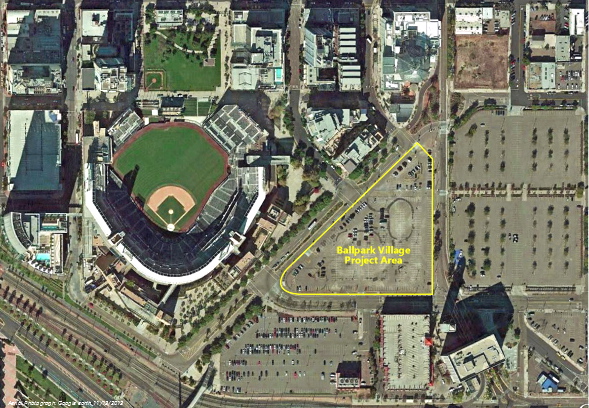
“Spengler will apply his unique skill set derived from combining remediation and grading activities and his extensive knowledge of the site to guide the remediation efforts for Ballpark Village in the most efficient and cost-effective manner possible,” the developers said in a report.
The Ballpark Village site was previously owned by San Diego Gas & Electric as part of the facilities associated with the historic manufactured gas plant located on the south side of Imperial Avenue, which was constructed in the late 1800s. After the closure of the plant, these properties continued to support SDG&E’s operations through to the late 1990s.
The developers said the Ballpark Village project will be largest undertaking in Downtown since the construction of Petco Park. Preconstruction work is scheduled to start during the first quarter of 2015 with demolition and grading set to start in March. Project completion is estimated for late 2017.
“I’ve been studying and excavating the East Village since 1998,” said Spengler. “Understanding the history is as important as understanding the environmental data. For proper planning, one must understand how and why the contamination came to be, and to not only rely on the data at face value.”

Cirque du Soleil’s ‘Varekai’ Opens Feb. 25
Cirque du Soleil’s latest arena touring production, “Varekai,” opens Feb. 25 for seven performances in the Valley View Casino Center, formerly the Sports Arena, in Point Loma.
The word Varekai (pronounced ver·ay·’kie) means “wherever” in the Romany language of gypsies, the universal wanderers.
Directed by Dominic Champagne, this production pays tribute to the nomadic soul, to the spirit and art of the circus tradition, and to those who quest with infinite passion along the path that leads to Varekai.
Tickets for the general public are available at www.cirquedusoleil.com/varekai or by calling (888) 929-7849. Ticket prices range from $35-$115.
Show Schedule:
Wednesday, Feb. 25 at 7:30 p.m.
Thursday, Feb. 26 at 7:30 p.m.
Friday, Feb. 27 at 7:30 p.m.
Saturday, Feb. 28 at 4 p.m. and 7:30 p.m .
Sunday, March 1 at 1:30 p.m. and 5 p.m .
For show and ticket information, visit www.cirquedusoleil.com/varekai.
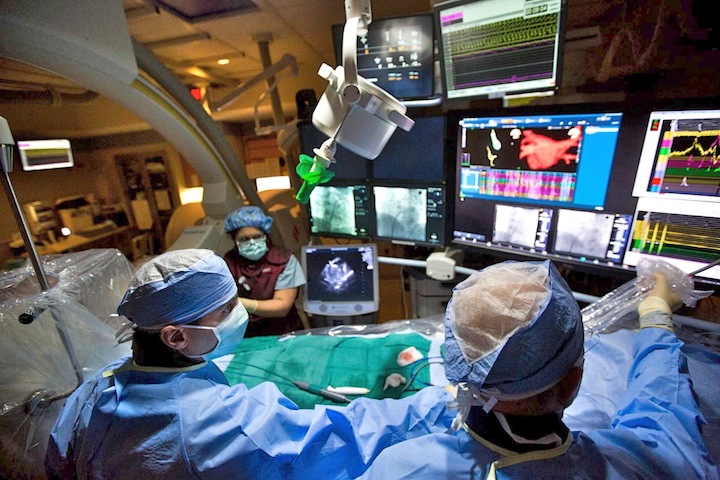
Eight Companies That Launched
Groundbreaking New Products Are Honored
Eight San Diego-based companies who launched groundbreaking new products in the last year were honored Dec. 5 as winners in the 27th annual Most Innovative New Product Awards sponsored by Connect, the business accelerator organization.
Held at the Hyatt Regency La Jolla at Aventine, the program was attended by more than 700 business leaders, entrepreneurs, researchers and investors.
The 2014 MIP Award winners and their products:
Aerospace and Security Technologies
Cyber Flow Analytics for FlowScape
Flowscape provides anomalytics for the Internet of Things. It continuously analyzes billions of unstructured application and network traffic flows, and applies machine learning algorithms to provide real-time actionable intelligence for anomalous behavior. FlowScape detects anomalous high-risk threats as a cyber-security platform.
Communications and IT
Cubic Transportation Systems for NextBus Fleet Management
The NextBus Fleet Management application is a modular, mobile gateway for connecting passengers and public transit managers to valuable real-time travel and operations information. This cost-effective, high-quality and reliable application makes public transportation a viable and attractive choice for commuters.
Diagnostics & Research Tools
Organovo Inc. for exVive3D Liver Model
exVive3D Liver model is functional 3D human liver tissue constructs consisting of multiple primary human cell types which are found in native human liver. The exVive3D Livers are created using Organovo’s proprietary 3D bioprinting technology that results in tissues containing precise and reproducible architecture. They are intended to improve preclinical drug discovery programs.
Pharmaceutical Drugs and Medical Devices
Topera Inc. for Topera’s 3D Mapping System
Topera’s 3D Mapping identifies the mechanism that sustains atrial fibrillation in arrhythmia patients. By helping physicians visualize and localize these precise sources the Topera System provides the essential information for excellent patient outcomes.
Mobile Apps
Rock My World Inc. for RockMyRun
RockMyRun takes biometric data from smartphones and fitness wearable devices, and then adjusts the music you’re listening to so that it matches your body, leading to increased enjoyment and improvement in performance by up to 20 percent while exercising.
Software
CloudBeds for CloudBeds
CloudBeds is an operating system for hotels where properties can manage their operations easily through online tools; distribute real-time inventory (rooms) to consumers and travel agents worldwide through popular channels around the web via 2-way APIs; and increase a property’s revenue while lowering its costs using learning algorithms that optimize a property’s room prices, availability and back-office tasks.
Sport & Active Lifestyle Technologies
Electrozyme LLC for ProFit SE Real-Time Sweat Electrolyte Sensor
The ProFit SE Real-Time Sweat is the world’s first personal hydration monitor capable of assessing fluid and electrolyte loss in a non-invasive, real-time fashion. The wearable product provides answers to three key questions: When is it time to rehydrate? What to rehydrate with? How much to rehydrate?
Sustainability
Solatube International for Solatube SkyVault Series
Solatube SkyVault Series employs advanced optics to deliver maximum daylight with minimal heat gain to large spaces with high, open ceilings. Modular components let designers spread light evenly, enhance light capture or control focus with one system.
Besides the companies honored, Connect awarded the Distinguished Contribution Award for Life Sciences Innovation to philanthropist T. Denny Sanford, and the Distinguished Contribution Award for Technology Innovation to Robert S. Sullivan, dean of the UC San Diego Rady School of Management.
Carlsbad Company Among Firms Getting FAA
Exemption To Use Drones in Filmmaking
A Carlsbad company — Aerial MOB LLC — is one of six aerial photo and video production companies that have been granted an exemption by the Federal Aviation Administration for the use of small unmanned aircraft systems for filmmaking in the United States.
Secretary of Transportation Anthony Foxx, speaking at a press conference on Tuesday, said in these cases the operation of UAS “does not pose a risk to national airspace users. It’s a crucial step for the integration of UAS into our aviation system,” and that companies seeking approval now have a model for doing so.
Currently, unmanned aircraft systems generally cannot be used for commercial purposes in the United States. While rules for the safe integration of SUAS into the national airspace are not expected until later this year, the exemption is allowed under Section 333 of the FAA Modernization and Reform Act of 2012.
This allowance does come with limitations, however as the aircraft must be operated by a three-man team, including a UAS operator with private pilot certification. All flying must be done within line-of-sight and can’t be operated at night. The operator must also submit a detailed plan of operations three days before any filming takes place with an inspection of aircraft before flights.
Early this summer, seven film companies filed highly similar petitions with the FAA to fly small unmanned aircraft systems less than 55 pounds to a height of no more than 400 feet on a closed set.
Besides Aerial MOB LLC, the companies that filed petitions were Flying-Cam, HeliVideo Productions LLC, Pictorvision Inc., RC Pro Productions Consulting LLC, Astraeus Aerial and Snaproll Media LLC. The only company not to receive an exemption was Flying-Cam, which is working with the FAA to provide additional required information.
************************************************************************
Cross-Border Bridge to Give Airline Passengers
Direct Access to Tijuana International Airport
Construction has started on the Cross Border Xpress, a new, elevated pedestrian bridge that will connect Tijuana International Airport to a new passenger facility in Otay Mesa to make life a whole lot easier for airline passengers crossing the border.
The bridge is part of a $120 million private project connecting a terminal on the U.S. side of the border directly into a foreign airport terminal — the first ever.
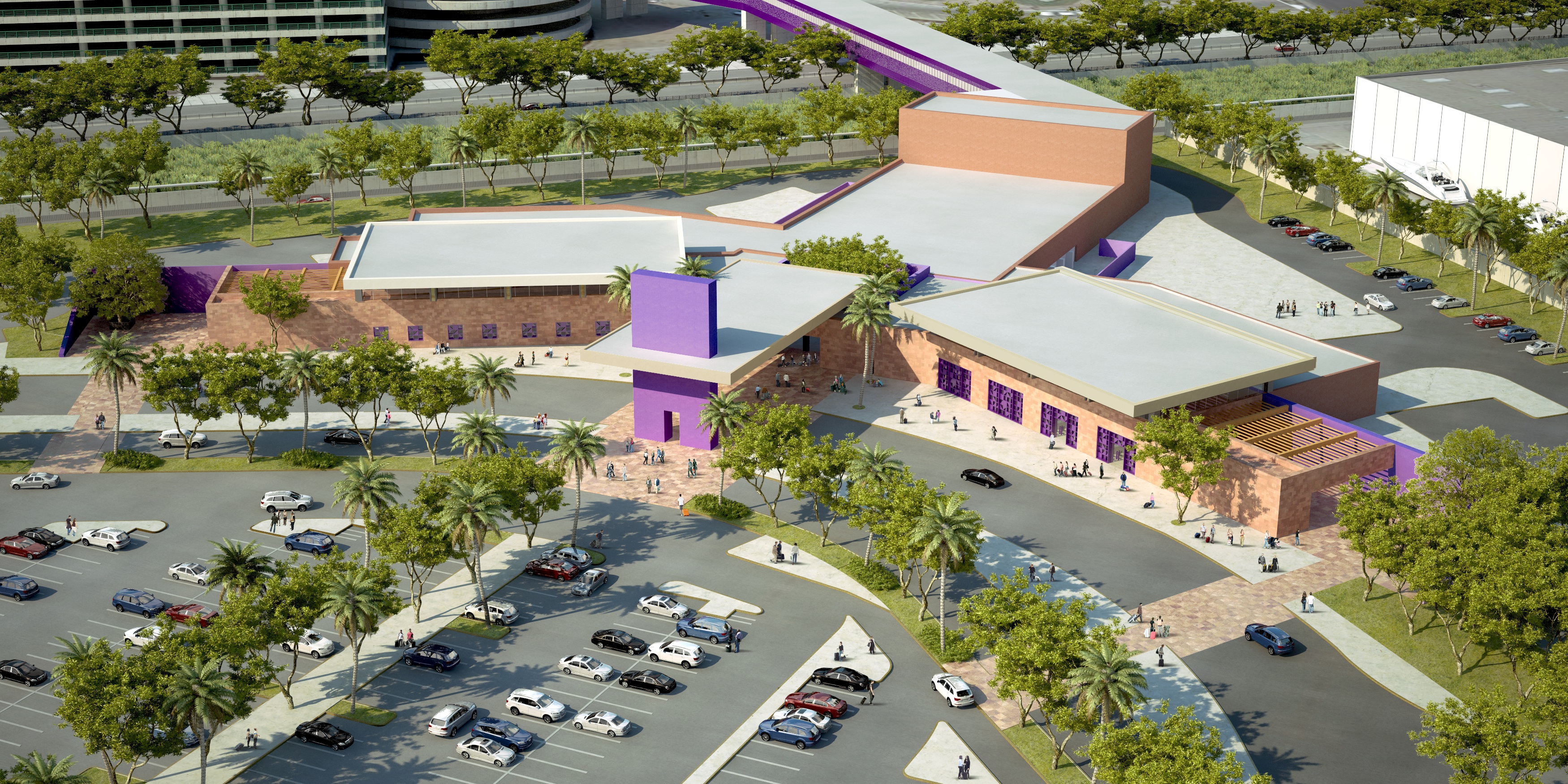
Officials said the Cross Border Xpress will serve the approximately 2.4 million passengers who already cross the border as part of their travels, and will help them avoid unpredictable, often long delays at congested San Ysidro and Otay Mesa land ports of entry. Users of the bridge will be able to access the more than 30 destinations within Mexico that Tijuana International Airport (TIJ) offers, many of which are not served by other Southern California airports. TIJ also has direct flights to Shanghai and Tokyo.

The terminal will be located south of Interstate 905 in Otay Mesa and is expected to open for passenger crossings in summer 2015.
The project is being developed and operated by Otay Tijuana Venture LLC, a private investment group with U.S. and Mexican shareholders. Investors include PAP Corp, Palareo Inc. and EGI-Otay Investors.
In the U.S., the Cross Border Xpress will feature more than 65,000 square feet of indoor and outdoor patio waiting areas for passengers and guests, retail, food and beverages, fully bilingual customer service and information, and short-to long-term parking. The bridge itself will be 390 feet long, enclosed with divided north/south corridors. Inside the TIJ terminal, construction is under way to accommodate the landing of the bridge and improve passenger facilities with new areas and amenities.
U. S. Customs and Border Protection, which has participated in the design of the San Diego facility, will staff operations at the Cross Border Xpress through an agreement with the project’s ownership.
“This is a great example of private investment creating much-needed public infrastructure to facilitate safe, secure travel and trade,” said Mark Cafferty, CEO of the San Diego Regional Economic Development Corp. “A multi-million dollar binational private investment in our region will create capacity for more than two million border crossing per year, that will translate to job creation, industrial development, and competitiveness for the San Diego-Tijuana Region.”
Officials said the Cross Border Xpress also will broaden Tijuana’s industrial, tourism and commercial platform while it also strengthens its position as a Maquiladora destination.
The project is being financed by Bancomext and Invex, with construction under way by Turner Construction and Hazard Construction in San Diego, and Grumesa S.A. de C. V. in Mexico. Architect Legoretta + Legoretta designed the project in conjunction with Stantec.
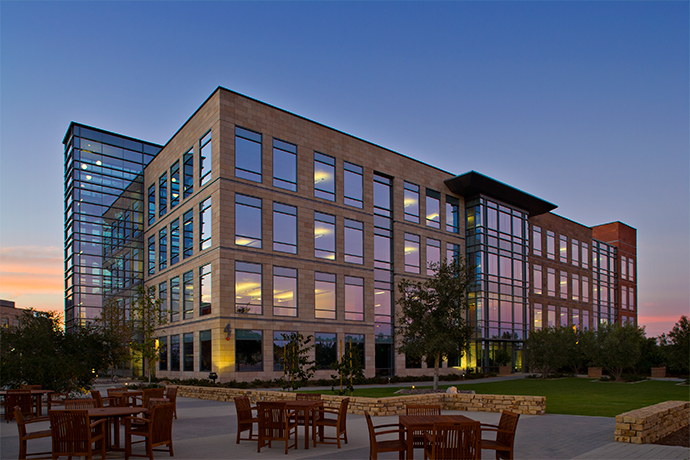
Illumina Agrees to 10-Year Business
Incentive Deal to Stay in San Diego
Medical equipment-maker Illumina will keep 300 manufacturing and sales employees in San Diego after reaching a 10-year, $1.5 million economic incentive agreement with the city, Mayor Kevin Faulconer and company officials announced.
Illumina, which makes devices for genetic analysis, was recently named the “Smartest Company in the World” by the Massachusetts Institute of Technology.
“This is a perfect example of how San Diego can support middle-class jobs while also encouraging economic growth,” Faulconer said. “This agreement keeps hundreds of high-wage jobs in San Diego, ensures city residents benefit from over a million dollars in annual sales tax revenue, and strengthens our region’s leadership in biotechnology.”
The company, which also has manufacturing facilities in Hayward and Singapore, was considering expanding elsewhere, including to Poway and Memphis, according to the mayor.
Illumina, the 12th-largest provider of sales and use tax revenue to the city, will apply the increase of such levies to the $1.5 million city credit, in exchange for keeping its workers in San Diego for the next decade.
The company leases a half-dozen buildings in San Diego totaling more than 560,000 square feet.
Council members enthusiastically approved similar agreements with craft brewers Ballast Point and AleSmith last month.
— City News Service

4 Appointed to S.D. Superior Court Bench
Gov. Jerry Brown has appointed two San Diegans and two Chula Vistans to the San Diego County Superior Court bench — Matthew C. Braner, Enrique E. Camarena, Selena D. Epley and Daniel F. Link.
Matthew Braner, 55, of San Diego, has served as supervisor at the San Diego County Primary Public Defender’s Office, Writs and Appeals Unit since 2009, where he has served as a deputy public defender since 1998.
Braner served as a felony trial deputy at the San Diego County Public Defender’s Office and was a trial deputy at the San Bernardino County Public Defender’s Office. He was an associate at the Law Offices of Christopher F. Emley. Braner earned a law degree from the University of California, Hastings College of the Law. He fills the vacancy created by the retirement of Judge Richard G. Cline. Braner is a Democrat.
Enrique Camarena, 40, of Chula Vista, has served as a deputy district attorney at the San Diego County District Attorney’s Office since 1999. He earned a law degree from the University of Southern California, Gould School of Law and a bachelor’s degree from Dartmouth College. Camarena fills the vacancy created by the retirement of Judge John S. Einhorn. Camarena is a Republican.
Selena Epley, 46, of Chula Vista, has served as assistant supervising attorney for a central felony team at the San Diego County Primary Public Defender’s Office since 2012, where she has served in several positions since 1995, including deputy public defender and training director at the South Bay Branch Office. She was a law clerk at the San Diego County Public Defender’s Office. Epley earned a law degree from Stanford Law School. She fills the vacancy created by the retirement of Judge William H. McAdam. Epley is a Democrat.
Daniel Link, 38, of San Diego, has served as a deputy district attorney at the San Diego County District Attorney’s Office since 2001, where he was a law clerk from 2000 to 2001. Link was president of the San Diego County Bar Association in 2011. He earned a law degree from the University of San Diego School of Law. He fills the vacancy created by the retirement of Judge Richard E. Mills. Link is a Democrat.
The compensation for each of these positions is $181, 292.
Green Flash Brewing Co. to Open Brewery in Poway
Green Flash Brewing Co. has taken out a 10-year, $1.28 million lease on a 12,275-square-foot industrial building in Poway to operate its second brewery in San Diego County. It is scheduled to open in early 2015.
Green Flash’s main location in the Sorrento Mesa area of San Diego features a 4,000-square-foot tasting room, beer garden, gift shop and production facility. The new location in Poway will be used to expand production capacity and will also feature a small tasting room and tours of the facility.
The building was leased from the Rice Family Trust and the Hartman Family Trust.
Green Flash Brewing Co. was founded by Mike and Lisa Hinkley in 2002.
Cassidy Turley and Urban Real Estate Services Inc. were the brokers in the lease transaction.

Stalled Horton Plaza Project
Gets A $4.5 Million Boost
A stalled project to turn a section of Horton Plaza into a public park received a $4.9 million budget increase from the San Diego City Council.
When the project began nearly two years ago with the demolition of the old Robinsons-May/Planet Hollywood building, city officials touted the park as a 37,000-square-foot public gathering place.
However, the boarded-up site on Broadway at Fourth Avenue has been inactive for many months because of haggling with state officials over whether money left over from the old redevelopment system could be used to pay for construction.
Problems with the property title and a substandard underground electrical box also caused delays.
“We had this amazing project that this council supported, but a funny thing happened on the way to the park — redevelopment got ended,” City Council President Todd Gloria said. “That occurred and the economy came back, so costs were higher.”
Officials with the City Attorney’s Office believe San Diego has a strong case to use redevelopment funds for the project.
The state Department of Finance has twice said the park project is an enforceable obligation for former redevelopment funding, but that was at a lower cost, Deputy City Attorney Kevin Reisch told the council members before they gave their unanimous support for increasing the budget.
The Department of Finance will have 45 days to consider the issue. If state officials say no, litigation could follow, Reisch said.
— City News Service
Balboa Park Conservancy and Balboa Park Central Merge
The Balboa Park Conservancy and Balboa Park Central, organizations dedicated to protecting and enhancing the park, have merged, the groups announced today. The merged organization will operate under the name of The Balboa Park Conservancy.
“Working on behalf of the entire Park, the newly merged Balboa Park Conservancy will work to keep Balboa Park magnificent by sustaining and enhancing its beauty and its historic, cultural and recreational character for the enduring enjoyment of all,” said Carol Chang, Conservancy board president.
Established in 1923 and operating the historic House of Hospitality since 1937, Balboa Park Central’s focus for the last 91 years has been on visitor experience, marketing the park and collaborative programs. Formed in 2011, the Conservancy works to help the city maintain and beautify the park.
Officials said the Conservancy will continue to operate its current programs, and combined with Central’s programs will include the Balboa Park Visitors Center; Balboa Park Marketing; Balboa Park Family Days; Balboa Park December Nights; and the identification of restoration and enhancement projects within the park — its first such major project being the restoration of the Botanical Building, anticipated to be completed in 2015.

Officials Dedicate Historic Raise of San Vicente Dam
The San Diego County Water Authority dedicated the San Vicente Dam Raise, the largest single expansion of water storage in San Diego County history.
Starting in 2009, crews raised San Vicente Dam by 117 feet, increasing its storage capacity by 152,000 acre-feet. The new capacity will allow water to be stored within the region for use in dry years.
The dam is also part of the region’s Emergency Storage Project, enhancing local storage in case an emergency such as an earthquake interrupts imported water deliveries.
Officials attending the ceremony included Thomas Wornham, chair of the San Diego County Water Authority board of directors; San Diego Mayor Kevin Faulconer; John Laird, secretary of the California Natural Resources Agency; and Maureen Stapleton, general manager of the Water Authority.
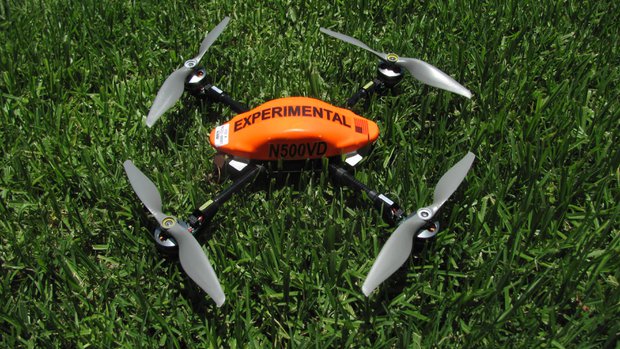
SDG&E to Test Small Drones in East County
San Diego Gas & Electric is the first utility in America to receive Federal Aviation Administration approval to test the use of small, unmanned aircraft to monitor electric and gas lines. The FAA granted a Special Airworthiness Certificate allowing the utility to research, test and train flight crews on the unmanned aircraft system, or UAS, in a sparsely populated airspace in east San Diego County.
The FAA certificate for SDG&E is significant because the agency has approved only very limited commercial use of unmanned aircraft as it works to develop comprehensive regulations by Sept. 30, 2015.
“The unmanned aircraft system provides us with another tool in our electric and gas operations tool chest,” said Dave Geier, SDG&E’s vice president of electric transmission and system engineering. “This versatile technology would allow us to improve our response to emergency situations such as fires, as well as complete aerial inspections in remote areas that are otherwise difficult to access, and locate the cause of power outages faster.”
Measuring 16 inches in diameter and weighing less than a pound, these small devices use a camera to inspect utility equipment and relay live images back to the controller. The UAS can examine infrastructure in areas that are off-limits to helicopters or difficult to access by road or other means.
Once the technology is tested, and if it proves effective, SDG&E may then seek FAA approval to use the aircraft more broadly in the field for inspections. SDG&E inspects more than 26,000 miles of transmission and distribution power lines for safety and compliance purposes and to make sure the grid is running smoothly and effectively.
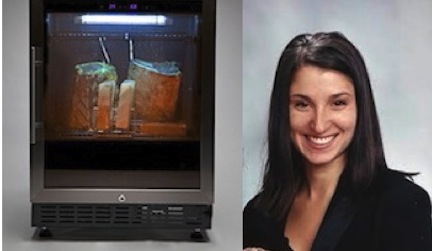
San Diego Company Developing World’s First
In-Home Dry-Age Refrigerator for Consumers
Nadia Bruno, a San Diego entrepreneur, is developing the first commercially available dry-age refrigerator for the home chef. Called the Steaklocker, it combines the best of old world dry-aging techniques with sophisticated modern technology, allowing the consumer to control the process.
Not only that, but by purchasing the beef in supermarkets and butcher shops, and then dry-aging at home, steak-lovers can save 50-70 percent on current retail dry-age steak prices. “Steaklocker is going to change the way people dine at home,” said Bruno.
Dry-aging steaks is a relatively simple process that has been used in fine restaurants for many years. It creates superbly tender and flavorful steaks by letting naturally-occurring enzymes slowly tenderize the meat in a controlled refrigerated environment. The steaks will continue to become more flavorful for up to 90 days.
Unfortunately, this cannot be done in a traditional home refrigerator because the high humidity and fluctuating temperatures promote bacterial growth, which can ruin the meat and create health issues, such as foodborne illnesses.
Bruno and her technical team are developing a state-of-the-art digital hygrometer controller, which allows consumers to adjust the recommended settings that vary the flavor and tenderness of the meat. In addition, the Steaklocker will also feature a smart app that provides instant feedback on the temperature and humidity operations of the refrigerator.
Steaklocker recently had a successful Kickstarter campaign in the food category. It was No. 1 in San Diego and No. 11 in food for the entire history of Kickstarter campaigns. It raised over $191,000.
To help continued funding of this project, she has launched an Indiegogo campaign, which can be viewed at: www.indiegogo.com/projects/steaklocker-the-world-s-first-chef-inspired-in-home-dry-age-steak-fridge.
“We need help from steak-lovers to finish this project,” Bruno said. “We have suppliers waiting to manufacture the fridge and engineering partners ready to finalize the electronics and wireless applications.”




